Boeing Supply Chain Management: Challenges, Strategies, and Analysis
VerifiedAdded on 2021/06/14
|19
|3442
|49
Report
AI Summary
This report provides a comprehensive analysis of Boeing's supply chain management, examining its evolution, current structure, and the challenges it faces in the aerospace industry. The report delves into Boeing's historical context, from the Boeing 314 Clipper to the 787 Dreamliner, highlighting the company's growth and the increasing complexity of its supply chain. It explores the potential challenges, including disruptions, subcontracting, and the need for effective communication across multiple tiers of suppliers. The report outlines Boeing's strategies for success, such as leveraging best-in-class suppliers, implementing common risk models, and utilizing advanced logistics tools. It also discusses the linkage between Boeing's activities and theoretical policies, including the implementation of lean supply chain strategies and the importance of sustainability throughout the value chain. The analysis emphasizes the global nature of Boeing's operations, the role of technology, and the significance of adaptability in a dynamic market.
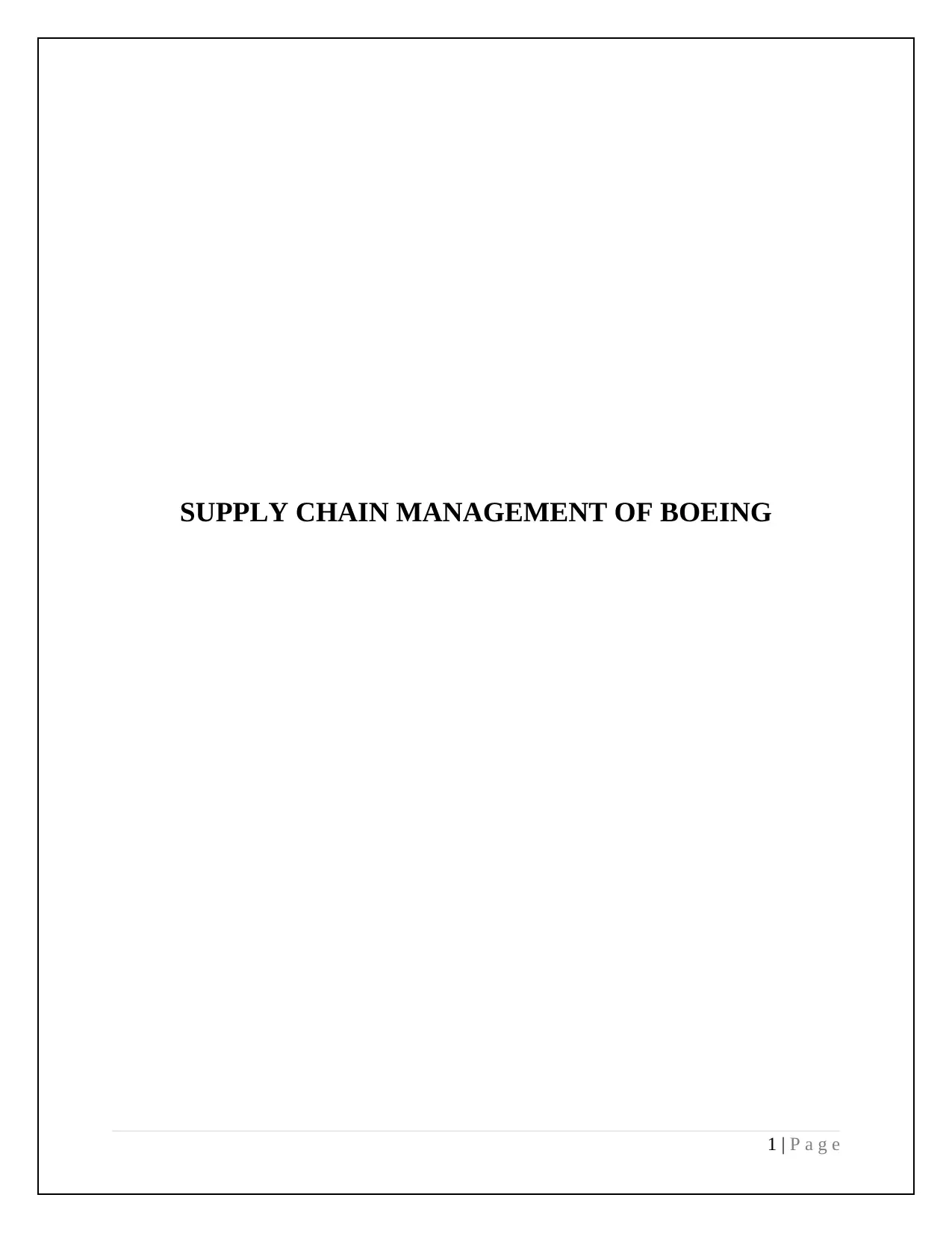
SUPPLY CHAIN MANAGEMENT OF BOEING
1 | P a g e
1 | P a g e
Paraphrase This Document
Need a fresh take? Get an instant paraphrase of this document with our AI Paraphraser
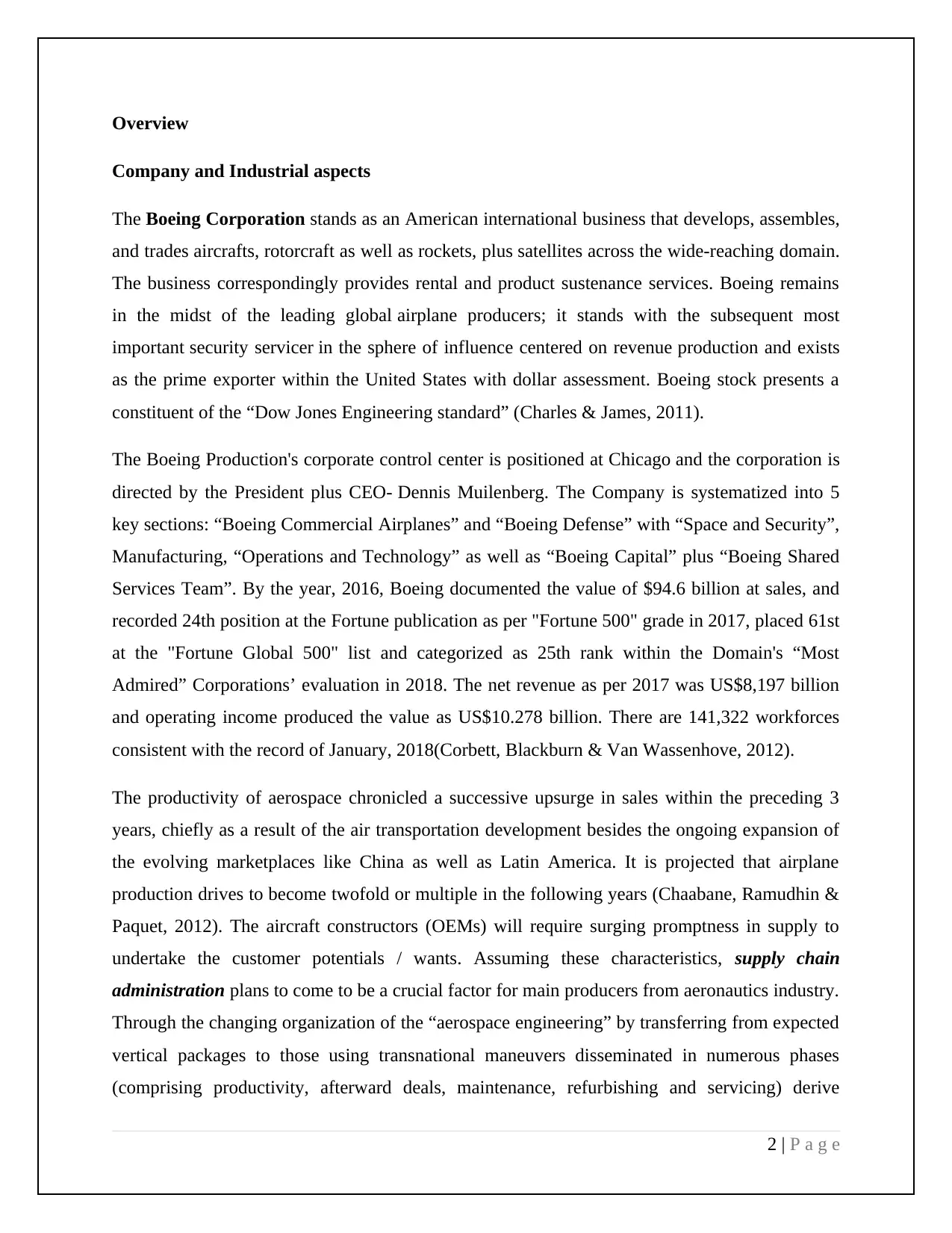
Overview
Company and Industrial aspects
The Boeing Corporation stands as an American international business that develops, assembles,
and trades aircrafts, rotorcraft as well as rockets, plus satellites across the wide-reaching domain.
The business correspondingly provides rental and product sustenance services. Boeing remains
in the midst of the leading global airplane producers; it stands with the subsequent most
important security servicer in the sphere of influence centered on revenue production and exists
as the prime exporter within the United States with dollar assessment. Boeing stock presents a
constituent of the “Dow Jones Engineering standard” (Charles & James, 2011).
The Boeing Production's corporate control center is positioned at Chicago and the corporation is
directed by the President plus CEO- Dennis Muilenberg. The Company is systematized into 5
key sections: “Boeing Commercial Airplanes” and “Boeing Defense” with “Space and Security”,
Manufacturing, “Operations and Technology” as well as “Boeing Capital” plus “Boeing Shared
Services Team”. By the year, 2016, Boeing documented the value of $94.6 billion at sales, and
recorded 24th position at the Fortune publication as per "Fortune 500" grade in 2017, placed 61st
at the "Fortune Global 500" list and categorized as 25th rank within the Domain's “Most
Admired” Corporations’ evaluation in 2018. The net revenue as per 2017 was US$8,197 billion
and operating income produced the value as US$10.278 billion. There are 141,322 workforces
consistent with the record of January, 2018(Corbett, Blackburn & Van Wassenhove, 2012).
The productivity of aerospace chronicled a successive upsurge in sales within the preceding 3
years, chiefly as a result of the air transportation development besides the ongoing expansion of
the evolving marketplaces like China as well as Latin America. It is projected that airplane
production drives to become twofold or multiple in the following years (Chaabane, Ramudhin &
Paquet, 2012). The aircraft constructors (OEMs) will require surging promptness in supply to
undertake the customer potentials / wants. Assuming these characteristics, supply chain
administration plans to come to be a crucial factor for main producers from aeronautics industry.
Through the changing organization of the “aerospace engineering” by transferring from expected
vertical packages to those using transnational maneuvers disseminated in numerous phases
(comprising productivity, afterward deals, maintenance, refurbishing and servicing) derive
2 | P a g e
Company and Industrial aspects
The Boeing Corporation stands as an American international business that develops, assembles,
and trades aircrafts, rotorcraft as well as rockets, plus satellites across the wide-reaching domain.
The business correspondingly provides rental and product sustenance services. Boeing remains
in the midst of the leading global airplane producers; it stands with the subsequent most
important security servicer in the sphere of influence centered on revenue production and exists
as the prime exporter within the United States with dollar assessment. Boeing stock presents a
constituent of the “Dow Jones Engineering standard” (Charles & James, 2011).
The Boeing Production's corporate control center is positioned at Chicago and the corporation is
directed by the President plus CEO- Dennis Muilenberg. The Company is systematized into 5
key sections: “Boeing Commercial Airplanes” and “Boeing Defense” with “Space and Security”,
Manufacturing, “Operations and Technology” as well as “Boeing Capital” plus “Boeing Shared
Services Team”. By the year, 2016, Boeing documented the value of $94.6 billion at sales, and
recorded 24th position at the Fortune publication as per "Fortune 500" grade in 2017, placed 61st
at the "Fortune Global 500" list and categorized as 25th rank within the Domain's “Most
Admired” Corporations’ evaluation in 2018. The net revenue as per 2017 was US$8,197 billion
and operating income produced the value as US$10.278 billion. There are 141,322 workforces
consistent with the record of January, 2018(Corbett, Blackburn & Van Wassenhove, 2012).
The productivity of aerospace chronicled a successive upsurge in sales within the preceding 3
years, chiefly as a result of the air transportation development besides the ongoing expansion of
the evolving marketplaces like China as well as Latin America. It is projected that airplane
production drives to become twofold or multiple in the following years (Chaabane, Ramudhin &
Paquet, 2012). The aircraft constructors (OEMs) will require surging promptness in supply to
undertake the customer potentials / wants. Assuming these characteristics, supply chain
administration plans to come to be a crucial factor for main producers from aeronautics industry.
Through the changing organization of the “aerospace engineering” by transferring from expected
vertical packages to those using transnational maneuvers disseminated in numerous phases
(comprising productivity, afterward deals, maintenance, refurbishing and servicing) derive
2 | P a g e
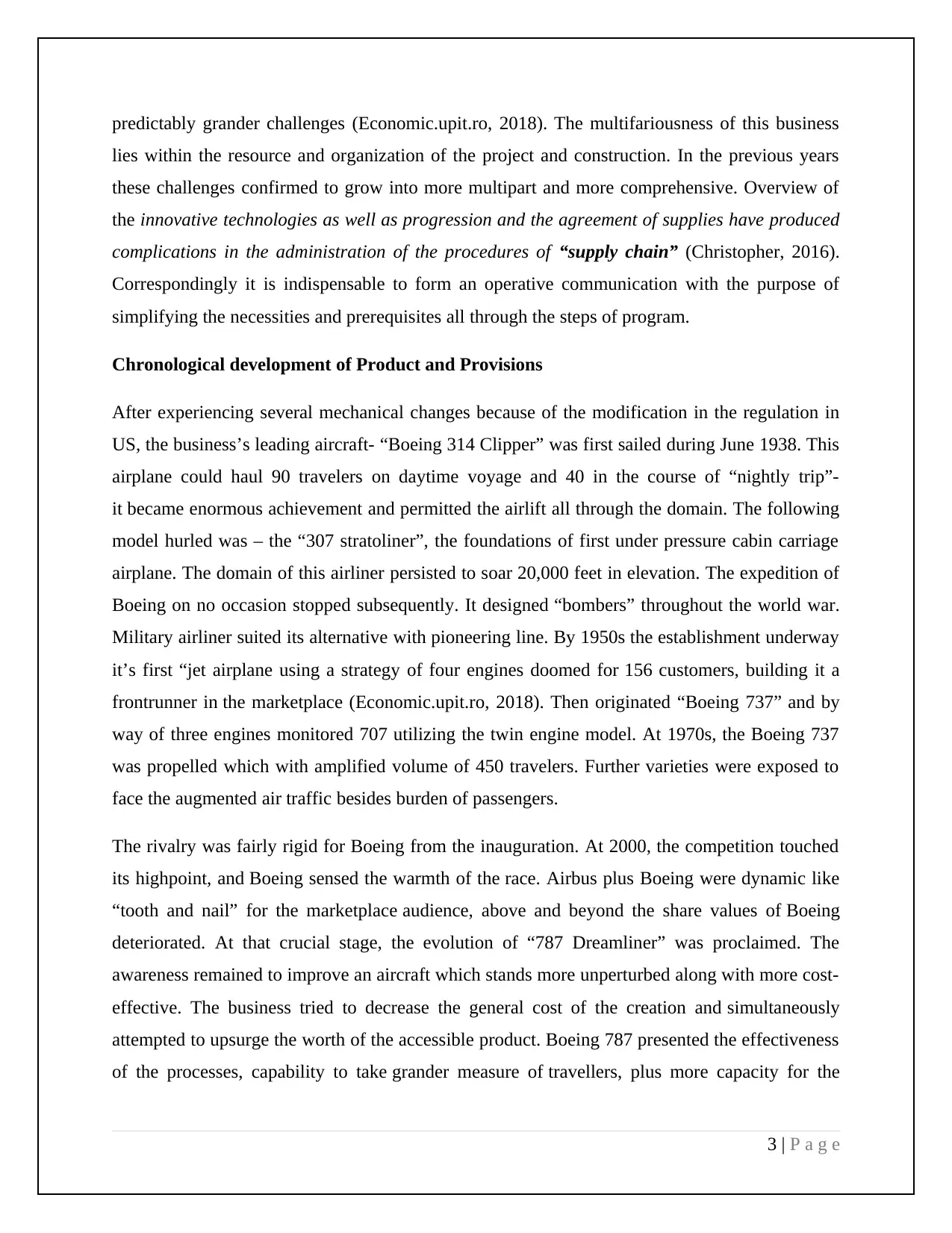
predictably grander challenges (Economic.upit.ro, 2018). The multifariousness of this business
lies within the resource and organization of the project and construction. In the previous years
these challenges confirmed to grow into more multipart and more comprehensive. Overview of
the innovative technologies as well as progression and the agreement of supplies have produced
complications in the administration of the procedures of “supply chain” (Christopher, 2016).
Correspondingly it is indispensable to form an operative communication with the purpose of
simplifying the necessities and prerequisites all through the steps of program.
Chronological development of Product and Provisions
After experiencing several mechanical changes because of the modification in the regulation in
US, the business’s leading aircraft- “Boeing 314 Clipper” was first sailed during June 1938. This
airplane could haul 90 travelers on daytime voyage and 40 in the course of “nightly trip”-
it became enormous achievement and permitted the airlift all through the domain. The following
model hurled was – the “307 stratoliner”, the foundations of first under pressure cabin carriage
airplane. The domain of this airliner persisted to soar 20,000 feet in elevation. The expedition of
Boeing on no occasion stopped subsequently. It designed “bombers” throughout the world war.
Military airliner suited its alternative with pioneering line. By 1950s the establishment underway
it’s first “jet airplane using a strategy of four engines doomed for 156 customers, building it a
frontrunner in the marketplace (Economic.upit.ro, 2018). Then originated “Boeing 737” and by
way of three engines monitored 707 utilizing the twin engine model. At 1970s, the Boeing 737
was propelled which with amplified volume of 450 travelers. Further varieties were exposed to
face the augmented air traffic besides burden of passengers.
The rivalry was fairly rigid for Boeing from the inauguration. At 2000, the competition touched
its highpoint, and Boeing sensed the warmth of the race. Airbus plus Boeing were dynamic like
“tooth and nail” for the marketplace audience, above and beyond the share values of Boeing
deteriorated. At that crucial stage, the evolution of “787 Dreamliner” was proclaimed. The
awareness remained to improve an aircraft which stands more unperturbed along with more cost-
effective. The business tried to decrease the general cost of the creation and simultaneously
attempted to upsurge the worth of the accessible product. Boeing 787 presented the effectiveness
of the processes, capability to take grander measure of travellers, plus more capacity for the
3 | P a g e
lies within the resource and organization of the project and construction. In the previous years
these challenges confirmed to grow into more multipart and more comprehensive. Overview of
the innovative technologies as well as progression and the agreement of supplies have produced
complications in the administration of the procedures of “supply chain” (Christopher, 2016).
Correspondingly it is indispensable to form an operative communication with the purpose of
simplifying the necessities and prerequisites all through the steps of program.
Chronological development of Product and Provisions
After experiencing several mechanical changes because of the modification in the regulation in
US, the business’s leading aircraft- “Boeing 314 Clipper” was first sailed during June 1938. This
airplane could haul 90 travelers on daytime voyage and 40 in the course of “nightly trip”-
it became enormous achievement and permitted the airlift all through the domain. The following
model hurled was – the “307 stratoliner”, the foundations of first under pressure cabin carriage
airplane. The domain of this airliner persisted to soar 20,000 feet in elevation. The expedition of
Boeing on no occasion stopped subsequently. It designed “bombers” throughout the world war.
Military airliner suited its alternative with pioneering line. By 1950s the establishment underway
it’s first “jet airplane using a strategy of four engines doomed for 156 customers, building it a
frontrunner in the marketplace (Economic.upit.ro, 2018). Then originated “Boeing 737” and by
way of three engines monitored 707 utilizing the twin engine model. At 1970s, the Boeing 737
was propelled which with amplified volume of 450 travelers. Further varieties were exposed to
face the augmented air traffic besides burden of passengers.
The rivalry was fairly rigid for Boeing from the inauguration. At 2000, the competition touched
its highpoint, and Boeing sensed the warmth of the race. Airbus plus Boeing were dynamic like
“tooth and nail” for the marketplace audience, above and beyond the share values of Boeing
deteriorated. At that crucial stage, the evolution of “787 Dreamliner” was proclaimed. The
awareness remained to improve an aircraft which stands more unperturbed along with more cost-
effective. The business tried to decrease the general cost of the creation and simultaneously
attempted to upsurge the worth of the accessible product. Boeing 787 presented the effectiveness
of the processes, capability to take grander measure of travellers, plus more capacity for the
3 | P a g e
⊘ This is a preview!⊘
Do you want full access?
Subscribe today to unlock all pages.

Trusted by 1+ million students worldwide

improved security of the customers. These landscapes prepared the Dreamliner to remain “a fruit
of judgment” for the establishment and the potential customers (eit.umd.edu, 2018).
With this understanding, the business “decided on” the growth of “787 Dreamliner”. The
airplane assured the functioning competence and enhanced wellbeing for the customers. The
structures caused in driving of enormous number of provisions for the aircraft. Nevertheless, the
Dreamliner persisted to be stuck by practically three years. In its place of 2008, it accomplished
its first trip in 2011. Notwithstanding the delay, not all concerns were stable. The airplane was
stranded owing to the “fire within the batteries in year, 2013” (Coyle, Langley, Novack &
Gibson, 2016).
Supply chain/logistics management from the source to the customer
Potential Challenges
Supply chains turned out to be susceptible to the interruptions that befell through the production
method. In the expansion platforms of newfangled generations of airplanes, the manufacturers
supported as a key purpose of lessening the time-period of the supplies released on the
marketplace above and beyond on the plan to share the grander expenses for improvement with
dealers. These novel packages include the enlargement of multifaceted technology in assignments
to upsurge airplane functioning competence by 15 - 20% (Christopher, 2016). It subcontracted
significant functional programs to dealers which they have carefully chosen. Correspondingly,
the outline of modernizations (merged, low fuel incorporating engines, avionics, electrical
arrangements, etc.) besides in particular cases, makeover of the earlier workshops into self-
governing businesses has further augmented the complication of the industrial chain. In spite of
the constructive possessions, this innovative method has produced more troubles in the
manufacturing practice (Foster.uw.edu, 2018).
4 | P a g e
of judgment” for the establishment and the potential customers (eit.umd.edu, 2018).
With this understanding, the business “decided on” the growth of “787 Dreamliner”. The
airplane assured the functioning competence and enhanced wellbeing for the customers. The
structures caused in driving of enormous number of provisions for the aircraft. Nevertheless, the
Dreamliner persisted to be stuck by practically three years. In its place of 2008, it accomplished
its first trip in 2011. Notwithstanding the delay, not all concerns were stable. The airplane was
stranded owing to the “fire within the batteries in year, 2013” (Coyle, Langley, Novack &
Gibson, 2016).
Supply chain/logistics management from the source to the customer
Potential Challenges
Supply chains turned out to be susceptible to the interruptions that befell through the production
method. In the expansion platforms of newfangled generations of airplanes, the manufacturers
supported as a key purpose of lessening the time-period of the supplies released on the
marketplace above and beyond on the plan to share the grander expenses for improvement with
dealers. These novel packages include the enlargement of multifaceted technology in assignments
to upsurge airplane functioning competence by 15 - 20% (Christopher, 2016). It subcontracted
significant functional programs to dealers which they have carefully chosen. Correspondingly,
the outline of modernizations (merged, low fuel incorporating engines, avionics, electrical
arrangements, etc.) besides in particular cases, makeover of the earlier workshops into self-
governing businesses has further augmented the complication of the industrial chain. In spite of
the constructive possessions, this innovative method has produced more troubles in the
manufacturing practice (Foster.uw.edu, 2018).
4 | P a g e
Paraphrase This Document
Need a fresh take? Get an instant paraphrase of this document with our AI Paraphraser

(Source: Economic.upit.ro, 2018)
Over and done with Boeing- currently functioning as the absolute assembler of the aircraft,
harmonizing the various mechanical and “systems partner sites” publicized across the world is
supreme to the industrial achievement. Boeing desires to coordinate demand/supply as well as
logistics facts across multifarious partner tiers, thus key mechanisms work out at the “Boeing
Everett, Washington” services at the exact time – following “Just in Time” concept for absolute
grouping above a 3- day interval (Ellinger, Chen, Tian & Armstrong, 2016).
5 | P a g e
Over and done with Boeing- currently functioning as the absolute assembler of the aircraft,
harmonizing the various mechanical and “systems partner sites” publicized across the world is
supreme to the industrial achievement. Boeing desires to coordinate demand/supply as well as
logistics facts across multifarious partner tiers, thus key mechanisms work out at the “Boeing
Everett, Washington” services at the exact time – following “Just in Time” concept for absolute
grouping above a 3- day interval (Ellinger, Chen, Tian & Armstrong, 2016).
5 | P a g e
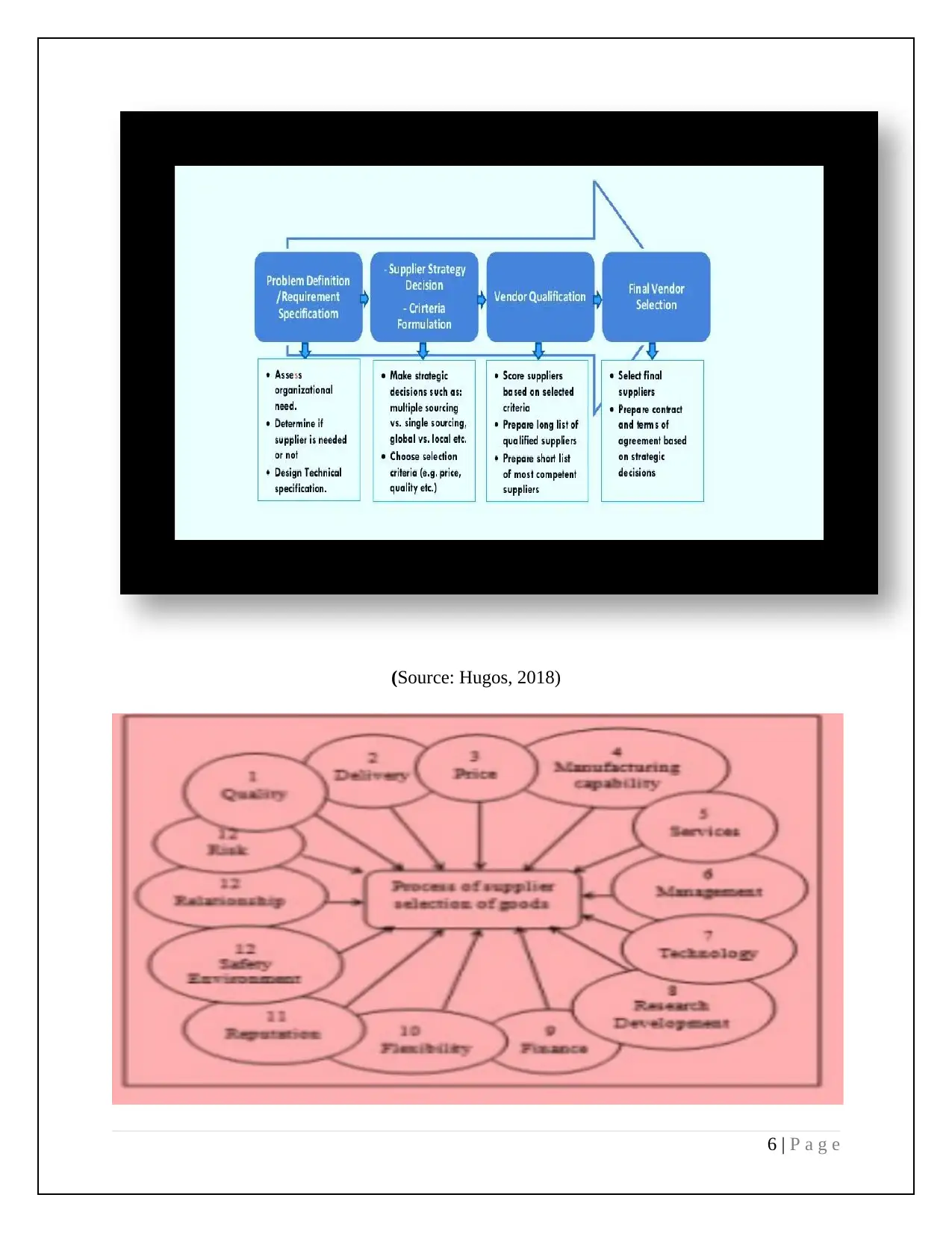
(Source: Hugos, 2018)
6 | P a g e
6 | P a g e
⊘ This is a preview!⊘
Do you want full access?
Subscribe today to unlock all pages.

Trusted by 1+ million students worldwide
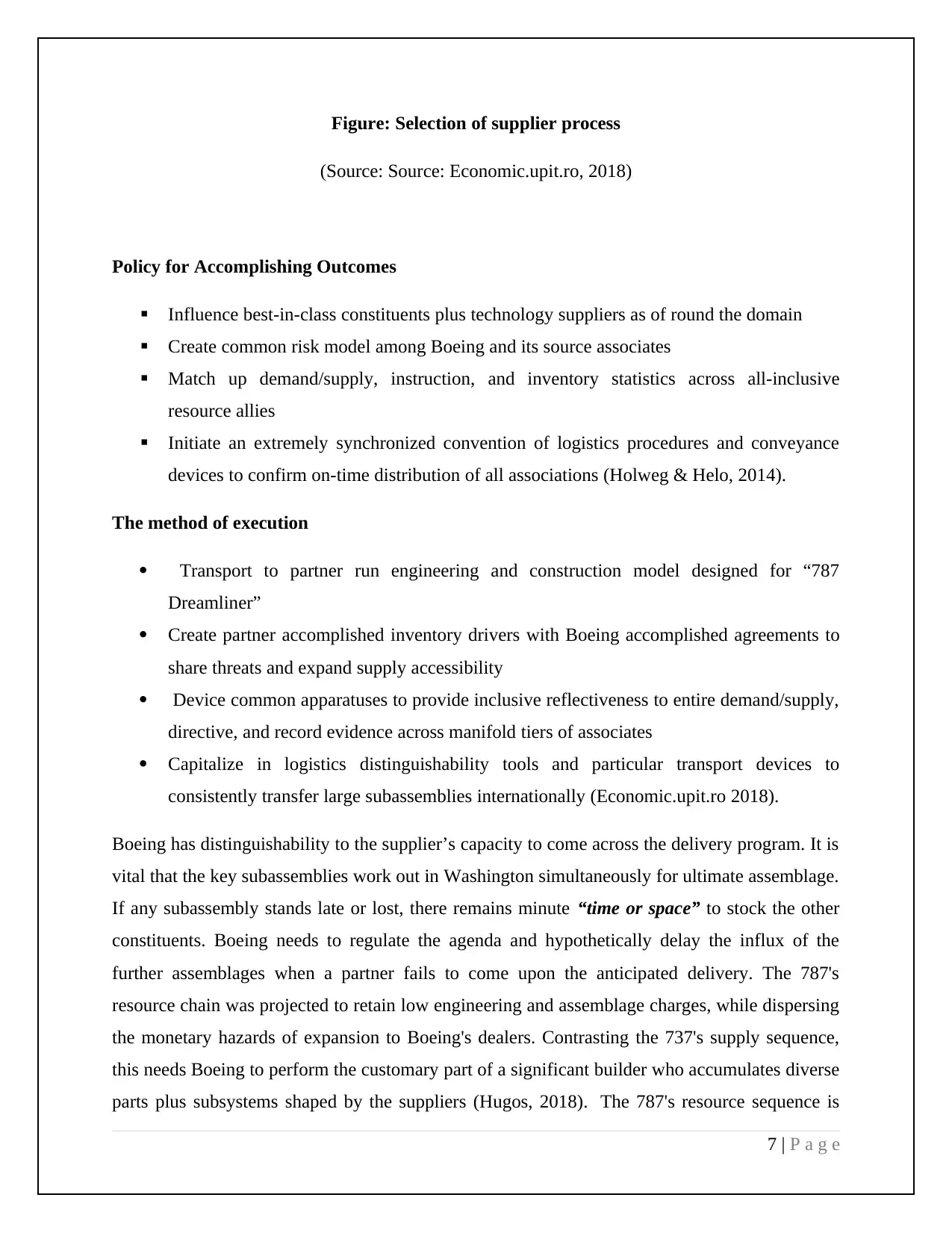
Figure: Selection of supplier process
(Source: Source: Economic.upit.ro, 2018)
Policy for Accomplishing Outcomes
Influence best-in-class constituents plus technology suppliers as of round the domain
Create common risk model among Boeing and its source associates
Match up demand/supply, instruction, and inventory statistics across all-inclusive
resource allies
Initiate an extremely synchronized convention of logistics procedures and conveyance
devices to confirm on-time distribution of all associations (Holweg & Helo, 2014).
The method of execution
Transport to partner run engineering and construction model designed for “787
Dreamliner”
Create partner accomplished inventory drivers with Boeing accomplished agreements to
share threats and expand supply accessibility
Device common apparatuses to provide inclusive reflectiveness to entire demand/supply,
directive, and record evidence across manifold tiers of associates
Capitalize in logistics distinguishability tools and particular transport devices to
consistently transfer large subassemblies internationally (Economic.upit.ro 2018).
Boeing has distinguishability to the supplier’s capacity to come across the delivery program. It is
vital that the key subassemblies work out in Washington simultaneously for ultimate assemblage.
If any subassembly stands late or lost, there remains minute “time or space” to stock the other
constituents. Boeing needs to regulate the agenda and hypothetically delay the influx of the
further assemblages when a partner fails to come upon the anticipated delivery. The 787's
resource chain was projected to retain low engineering and assemblage charges, while dispersing
the monetary hazards of expansion to Boeing's dealers. Contrasting the 737's supply sequence,
this needs Boeing to perform the customary part of a significant builder who accumulates diverse
parts plus subsystems shaped by the suppliers (Hugos, 2018). The 787's resource sequence is
7 | P a g e
(Source: Source: Economic.upit.ro, 2018)
Policy for Accomplishing Outcomes
Influence best-in-class constituents plus technology suppliers as of round the domain
Create common risk model among Boeing and its source associates
Match up demand/supply, instruction, and inventory statistics across all-inclusive
resource allies
Initiate an extremely synchronized convention of logistics procedures and conveyance
devices to confirm on-time distribution of all associations (Holweg & Helo, 2014).
The method of execution
Transport to partner run engineering and construction model designed for “787
Dreamliner”
Create partner accomplished inventory drivers with Boeing accomplished agreements to
share threats and expand supply accessibility
Device common apparatuses to provide inclusive reflectiveness to entire demand/supply,
directive, and record evidence across manifold tiers of associates
Capitalize in logistics distinguishability tools and particular transport devices to
consistently transfer large subassemblies internationally (Economic.upit.ro 2018).
Boeing has distinguishability to the supplier’s capacity to come across the delivery program. It is
vital that the key subassemblies work out in Washington simultaneously for ultimate assemblage.
If any subassembly stands late or lost, there remains minute “time or space” to stock the other
constituents. Boeing needs to regulate the agenda and hypothetically delay the influx of the
further assemblages when a partner fails to come upon the anticipated delivery. The 787's
resource chain was projected to retain low engineering and assemblage charges, while dispersing
the monetary hazards of expansion to Boeing's dealers. Contrasting the 737's supply sequence,
this needs Boeing to perform the customary part of a significant builder who accumulates diverse
parts plus subsystems shaped by the suppliers (Hugos, 2018). The 787's resource sequence is
7 | P a g e
Paraphrase This Document
Need a fresh take? Get an instant paraphrase of this document with our AI Paraphraser
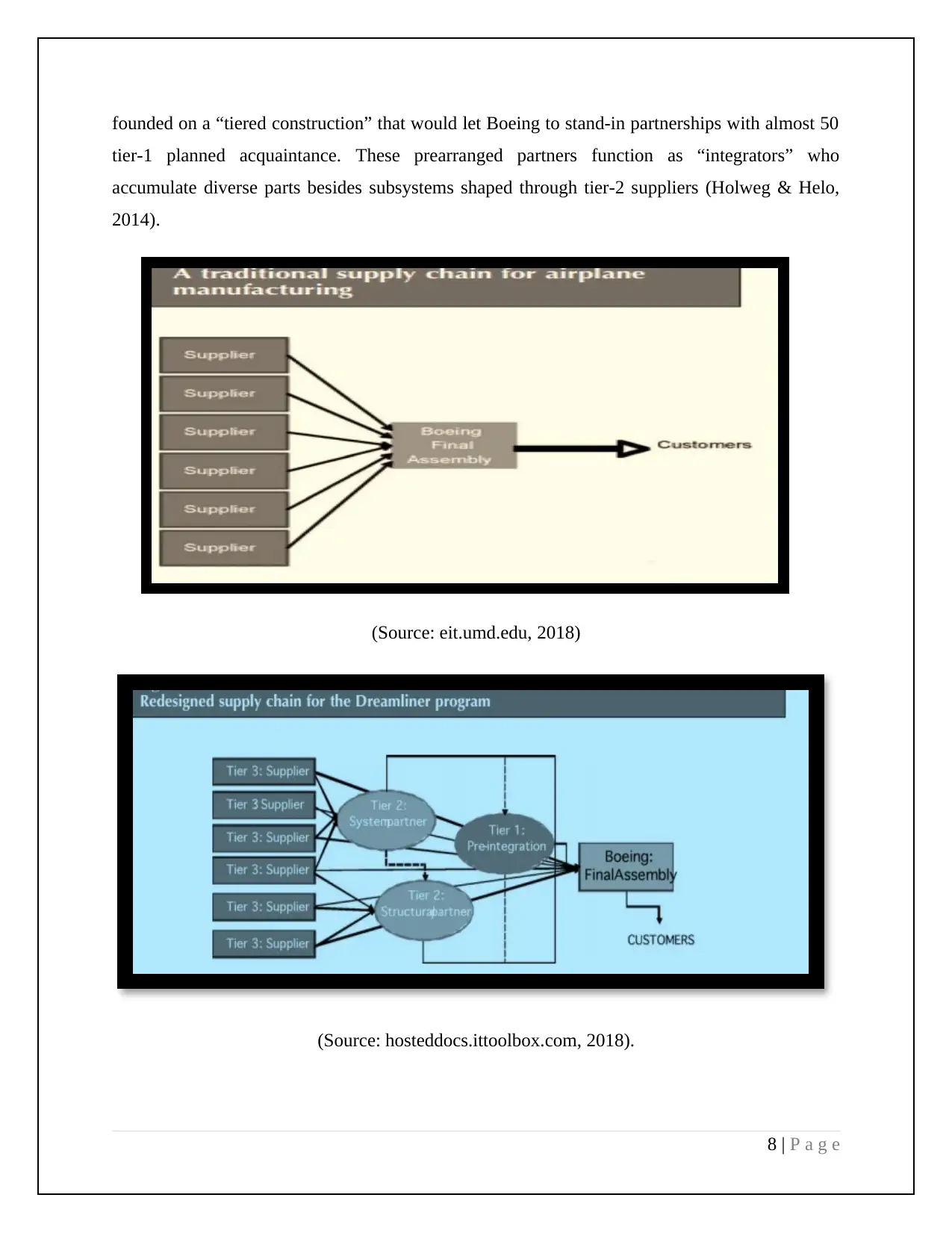
founded on a “tiered construction” that would let Boeing to stand-in partnerships with almost 50
tier-1 planned acquaintance. These prearranged partners function as “integrators” who
accumulate diverse parts besides subsystems shaped through tier-2 suppliers (Holweg & Helo,
2014).
(Source: eit.umd.edu, 2018)
(Source: hosteddocs.ittoolbox.com, 2018).
8 | P a g e
tier-1 planned acquaintance. These prearranged partners function as “integrators” who
accumulate diverse parts besides subsystems shaped through tier-2 suppliers (Holweg & Helo,
2014).
(Source: eit.umd.edu, 2018)
(Source: hosteddocs.ittoolbox.com, 2018).
8 | P a g e
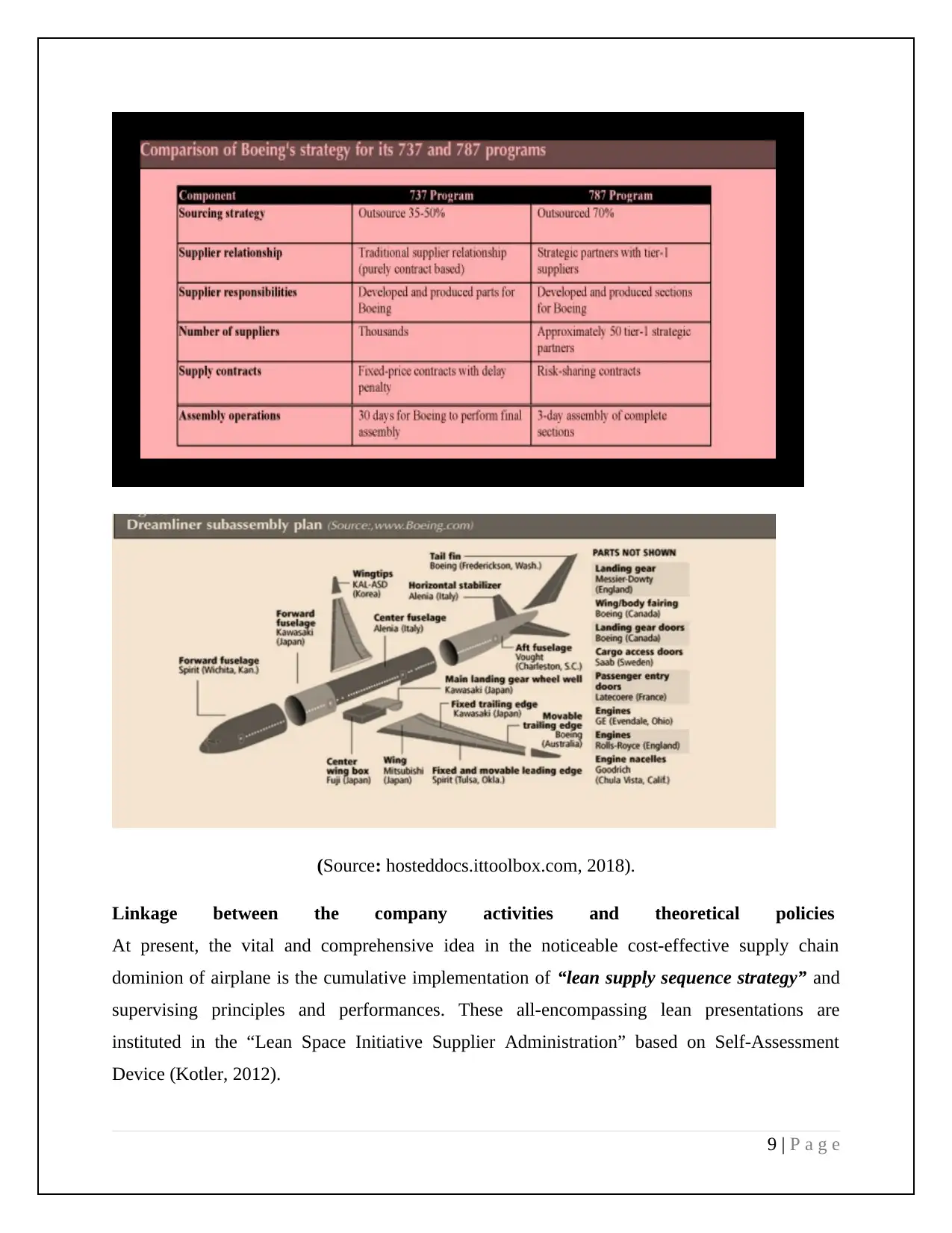
(Source: hosteddocs.ittoolbox.com, 2018).
Linkage between the company activities and theoretical policies
At present, the vital and comprehensive idea in the noticeable cost-effective supply chain
dominion of airplane is the cumulative implementation of “lean supply sequence strategy” and
supervising principles and performances. These all-encompassing lean presentations are
instituted in the “Lean Space Initiative Supplier Administration” based on Self-Assessment
Device (Kotler, 2012).
9 | P a g e
Linkage between the company activities and theoretical policies
At present, the vital and comprehensive idea in the noticeable cost-effective supply chain
dominion of airplane is the cumulative implementation of “lean supply sequence strategy” and
supervising principles and performances. These all-encompassing lean presentations are
instituted in the “Lean Space Initiative Supplier Administration” based on Self-Assessment
Device (Kotler, 2012).
9 | P a g e
⊘ This is a preview!⊘
Do you want full access?
Subscribe today to unlock all pages.

Trusted by 1+ million students worldwide
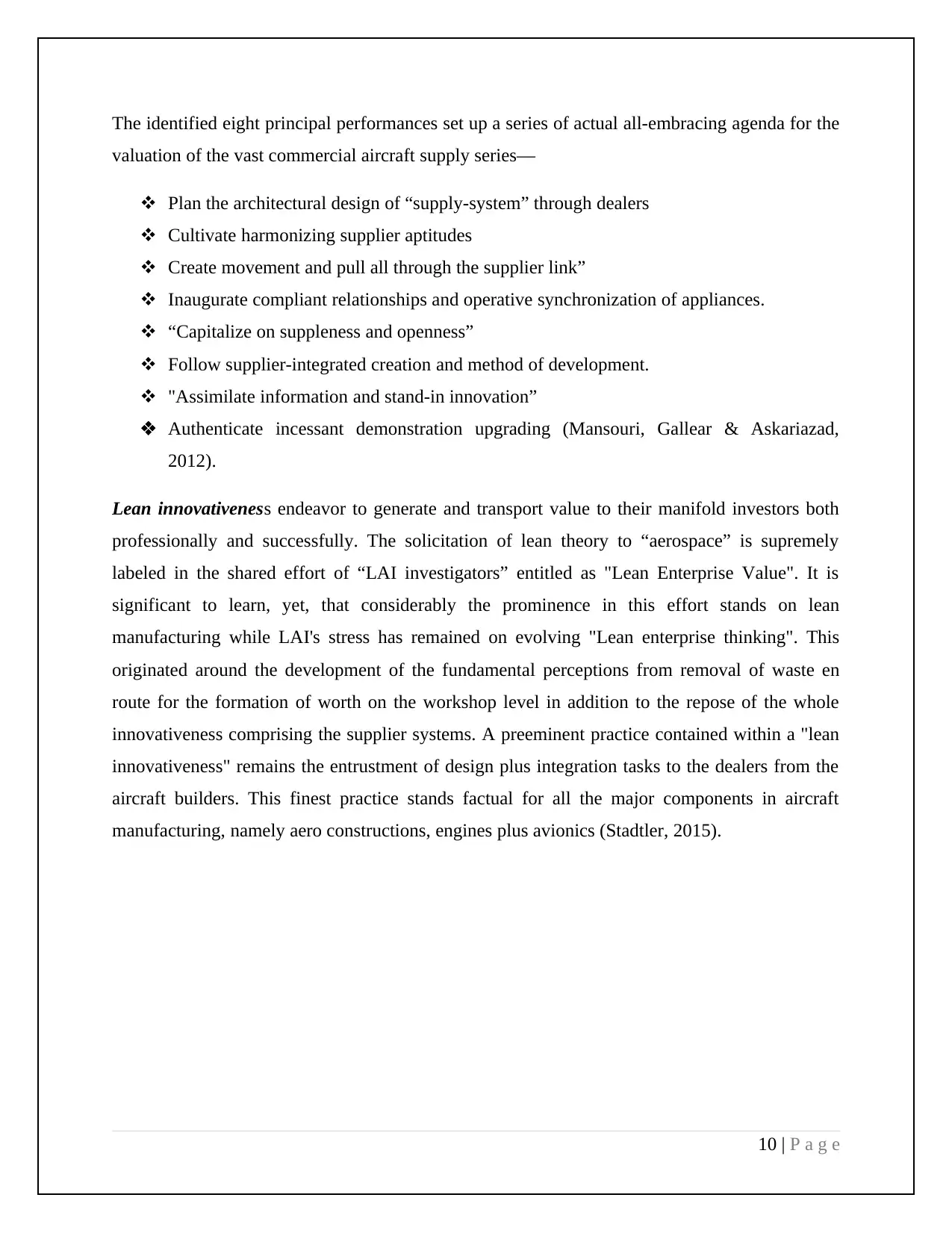
The identified eight principal performances set up a series of actual all-embracing agenda for the
valuation of the vast commercial aircraft supply series—
Plan the architectural design of “supply-system” through dealers
Cultivate harmonizing supplier aptitudes
Create movement and pull all through the supplier link”
Inaugurate compliant relationships and operative synchronization of appliances.
“Capitalize on suppleness and openness”
Follow supplier-integrated creation and method of development.
"Assimilate information and stand-in innovation”
Authenticate incessant demonstration upgrading (Mansouri, Gallear & Askariazad,
2012).
Lean innovativeness endeavor to generate and transport value to their manifold investors both
professionally and successfully. The solicitation of lean theory to “aerospace” is supremely
labeled in the shared effort of “LAI investigators” entitled as "Lean Enterprise Value". It is
significant to learn, yet, that considerably the prominence in this effort stands on lean
manufacturing while LAI's stress has remained on evolving "Lean enterprise thinking". This
originated around the development of the fundamental perceptions from removal of waste en
route for the formation of worth on the workshop level in addition to the repose of the whole
innovativeness comprising the supplier systems. A preeminent practice contained within a "lean
innovativeness" remains the entrustment of design plus integration tasks to the dealers from the
aircraft builders. This finest practice stands factual for all the major components in aircraft
manufacturing, namely aero constructions, engines plus avionics (Stadtler, 2015).
10 | P a g e
valuation of the vast commercial aircraft supply series—
Plan the architectural design of “supply-system” through dealers
Cultivate harmonizing supplier aptitudes
Create movement and pull all through the supplier link”
Inaugurate compliant relationships and operative synchronization of appliances.
“Capitalize on suppleness and openness”
Follow supplier-integrated creation and method of development.
"Assimilate information and stand-in innovation”
Authenticate incessant demonstration upgrading (Mansouri, Gallear & Askariazad,
2012).
Lean innovativeness endeavor to generate and transport value to their manifold investors both
professionally and successfully. The solicitation of lean theory to “aerospace” is supremely
labeled in the shared effort of “LAI investigators” entitled as "Lean Enterprise Value". It is
significant to learn, yet, that considerably the prominence in this effort stands on lean
manufacturing while LAI's stress has remained on evolving "Lean enterprise thinking". This
originated around the development of the fundamental perceptions from removal of waste en
route for the formation of worth on the workshop level in addition to the repose of the whole
innovativeness comprising the supplier systems. A preeminent practice contained within a "lean
innovativeness" remains the entrustment of design plus integration tasks to the dealers from the
aircraft builders. This finest practice stands factual for all the major components in aircraft
manufacturing, namely aero constructions, engines plus avionics (Stadtler, 2015).
10 | P a g e
Paraphrase This Document
Need a fresh take? Get an instant paraphrase of this document with our AI Paraphraser

(Source: Hugos, 2018)
The globally discrete nature of profitable manufacturing, investigation and developmental
competences of dealers is owing to the countless harmonies pooled by military plus civil airplane
machineries. The trade is similarly much structured, particularly for the protection of its
11 | P a g e
The globally discrete nature of profitable manufacturing, investigation and developmental
competences of dealers is owing to the countless harmonies pooled by military plus civil airplane
machineries. The trade is similarly much structured, particularly for the protection of its
11 | P a g e
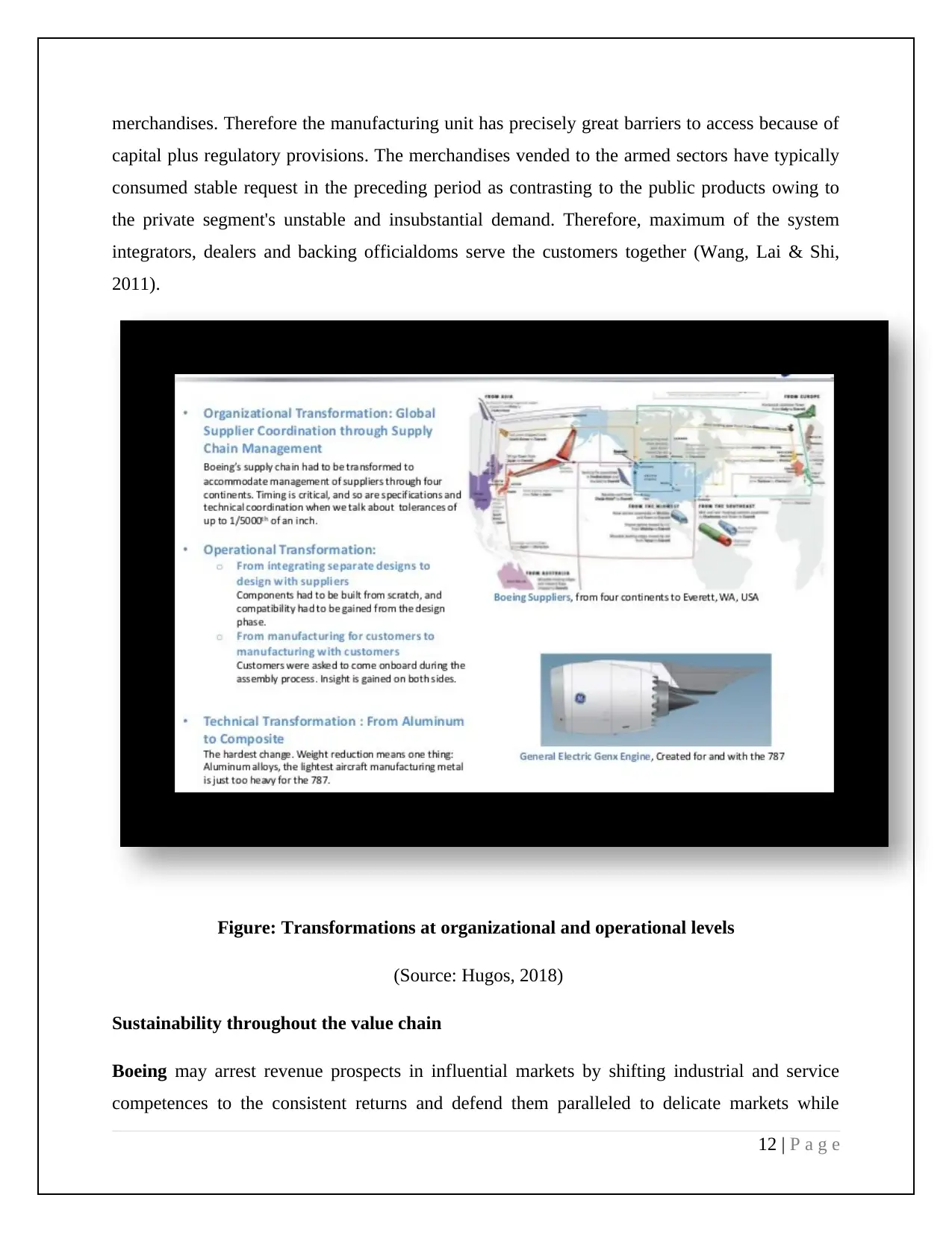
merchandises. Therefore the manufacturing unit has precisely great barriers to access because of
capital plus regulatory provisions. The merchandises vended to the armed sectors have typically
consumed stable request in the preceding period as contrasting to the public products owing to
the private segment's unstable and insubstantial demand. Therefore, maximum of the system
integrators, dealers and backing officialdoms serve the customers together (Wang, Lai & Shi,
2011).
Figure: Transformations at organizational and operational levels
(Source: Hugos, 2018)
Sustainability throughout the value chain
Boeing may arrest revenue prospects in influential markets by shifting industrial and service
competences to the consistent returns and defend them paralleled to delicate markets while
12 | P a g e
capital plus regulatory provisions. The merchandises vended to the armed sectors have typically
consumed stable request in the preceding period as contrasting to the public products owing to
the private segment's unstable and insubstantial demand. Therefore, maximum of the system
integrators, dealers and backing officialdoms serve the customers together (Wang, Lai & Shi,
2011).
Figure: Transformations at organizational and operational levels
(Source: Hugos, 2018)
Sustainability throughout the value chain
Boeing may arrest revenue prospects in influential markets by shifting industrial and service
competences to the consistent returns and defend them paralleled to delicate markets while
12 | P a g e
⊘ This is a preview!⊘
Do you want full access?
Subscribe today to unlock all pages.

Trusted by 1+ million students worldwide
1 out of 19
Related Documents
Your All-in-One AI-Powered Toolkit for Academic Success.
+13062052269
info@desklib.com
Available 24*7 on WhatsApp / Email
![[object Object]](/_next/static/media/star-bottom.7253800d.svg)
Unlock your academic potential
Copyright © 2020–2026 A2Z Services. All Rights Reserved. Developed and managed by ZUCOL.




